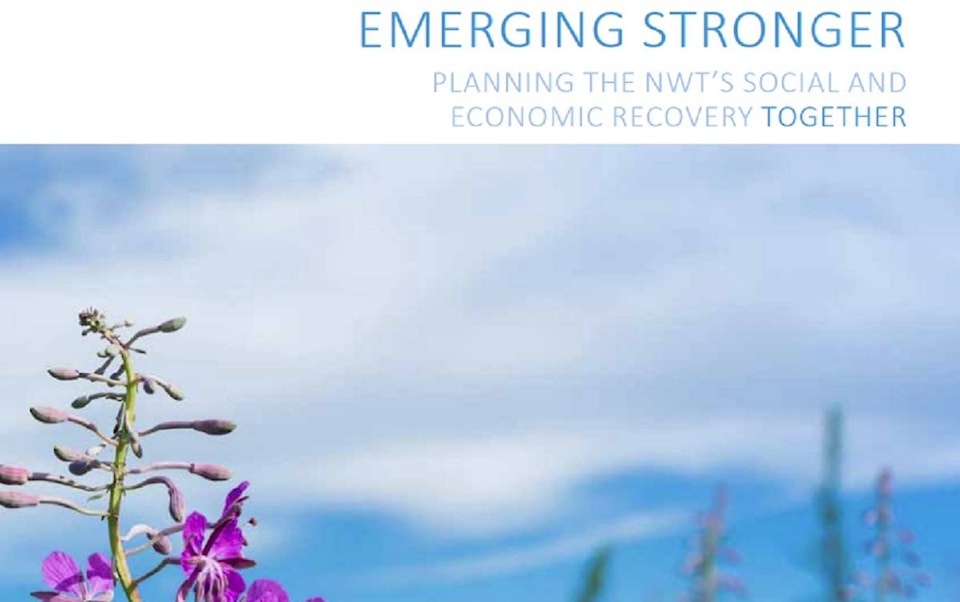Premier Caroline Cochrane tabled on May 31 the GNWT’s new draft of its Emerging Stronger plan on recovery from the COVID-19 pandemic that targets key areas of social and economic need, with implementation time lines set as late as 2025.
READ HERE: Emerging Stronger: Planning the NWT’s Social and Economic Recovery Together
The GNWT and MLAs have been discussing Emerging Stronger for more than one year, after an initial draft of the economic and social recovery plan was first presented to MLAs in a power point presentation in April 2020, to lukewarm responses from legislators and industry.
RELATED REPORTING: MLAs tell Cabinet to focus on small business while rebuilding NWT economy
RELATED REPORTING: Chamber of Mines blasts ‘weak’ GNWT recovery strategy that omits mining industry
Tied closely to the government’s 2019-2023 mandate priorities, Cochrane said Emerging Stronger complements the mandate by highlighting areas where further growth is needed such as in creating jobs, strengthening and diversifying the economy, building wellness and increasing government efficiency and responsiveness.
Few budgetary targets or estimates are provided in the plan.
Initial lessons learned
The pandemic exposed longstanding challenges facing the NWT that are summarized in the plan under the section titled Initial Lessons Learned.
Noteworthy among those items, the plan calls for building “stronger partnerships with Indigenous governments and organizations, community governments and the non-profit and charitable sector” by creating an external advisory table to strengthen the capacity of the not-for-profit sector and continue to directly engage with Indigenous governments through a multilateral table.
In an appendix section of the plan, the time line for those goals is set at fall 2021, with the establishment of an external advisory table listed as a means of tracking progress.
Broadband infrastructure
The plan urges that more efforts be made to support broadband infrastructure for fast and reliable internet services across the territory, as the pandemic demonstrated the importance of internet access for health and social services, education and business.
“Existing efforts to bridge the digital divide must advance in order to support a sustainable, long-term recovery. It must be recognized that technology is now integral to how the GNWT and residents do business, and reliability and accessibility must be established for all communities,” the document states.
As part of that initiative, the GNWT pledges to continue to seek federal policy changes to ensure applications for investment recognize the NWT’s challenges.
The time line for that is listed as “ongoing” and progress will be shown by lobbying the federal government for policy change.
Vulnerable populations
A section titled Meet the Needs of Vulnerable Populations acknowledges that the pandemic impacted residents’ abilities to meet basic needs and saw an increased reliance on income assistance (IA).
The GNWT plans to improve the IA program to ensure that the types and levels of benefits and income exemptions meet the basic needs of residents by 2023, when the changes to IA will be implemented.
Using NWT-specific information to create an NWT approach to managed alcohol will be ready by September 2021 when the model is expected to be ready.
Conducting a review of Northwest Territories Housing Corporation policies is to be completed in 2021, with policy changes made and enacted.
Support the hardest hit sectors, such as tourism, wholesale trade, accommodation and mining, calls for further assistance for those areas, investing through NWT Tourism in marketing for Canadian domestic travellers and helping mineral exploration prospectors extend their land tenure via the Work Credit Program for those currently unable to work.
Those goals are targeted in 2021 “and ongoing.”
Economic diversification
Emerging Stronger’s Expand and Diversify the Economy section notes that existing diamond mines will likely close in the next two to 20 years. The remediation activities associated with natural resource project closures will offer regional employment opportunities.
Though almost half of the NWT labour force is employed by the public sector, the pandemic showed the disparities between public and private sectors and demonstrated the need for economic diversification.
The GNWT pledges to work with Indigenous governments, development corporations, the mining industry and regulatory partners to move forward proposed mine expansions and projects to the production phase with community support, targeted for spring 2021 and ongoing, when communications tools will updated to bring stakeholders together for developing a common vision for resource development.
Attracting prospecting and exploration in areas of high mineral potential is aimed at Spring 2022, when promotion and marketing efforts will be adapted to new methods of communication, path-finding for explorers will be coordinated and Mining Incentive Program funding will be expanded to more projects.
Updating the economic diversification strategies, including the Agriculture Strategy, which includes a focus on small scale foods, the NWT Arts Strategy and the NWT Film Strategy is slated to begin in summer 2021, when strategies will be tabled and implementation plans reported on.
